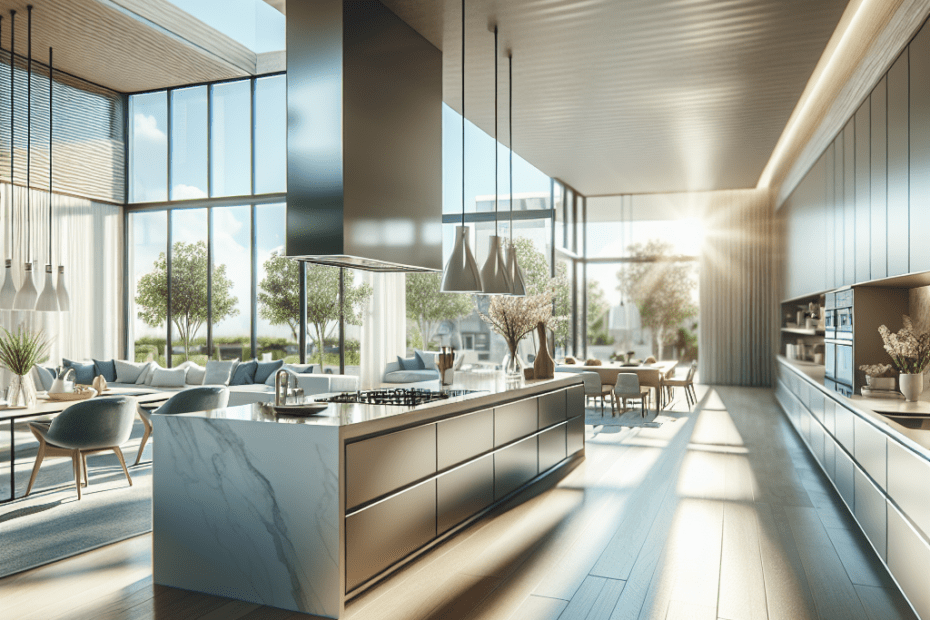“`html
The Power of Open-Concept Kitchens in Modern Homes
They have become more popular as families and homebuyers seek spaces that provide tranquility, ease of interaction, and versatility. These open-concept kitchens are stealing the show in many contemporary dwellings. By breaking down old barriers, literally, these designs introduce a new level of comfort and functionality, making them a sought-after choice for those redefining their living spaces.
Benefits of Open-Concept Kitchens
Open-concept kitchens offer a host of benefits that cater to the modern family’s needs. By eliminating walls, they create a seamless flow between cooking, dining, and living areas. This setup aligns with the trend of blending the kitchen with social spaces, fostering togetherness and making it ideal for hosting guests or spending time with family.
- Enhanced Social Interaction: With no walls to confine different activities, families can engage with each other during meal prep, family dinners, or social gatherings.
- Improved Natural Light: Open spaces allow light to travel freely, which brightens up the home and can potentially reduce electricity use during daytime.
- Increasing Home Value: According to a study by Houzz, 54% of homeowners who upgraded to open-concept kitchens said it significantly increased their home’s value.
Cultural Shifts and Trends
The popularity of open-concept kitchens reflects broader cultural shifts. Society is moving away from formal dining rooms and isolated kitchens to more informal and accessible spaces. This trend is particularly prevalent among millennials who value casual, social-living environments.
Additionally, there’s a shift towards multitasking in everyday life. The kitchen is no longer just a place for cooking; it’s a hub for various activities, including working from home, helping kids with homework, or simply hanging out.
Designing an Open-Concept Kitchen
Creating an open-concept kitchen involves more than removing walls. Thoughtful design is essential for maintaining an effective balance between openness and functionality.
| Design Element | Key Considerations |
|---|---|
| Layout | Ensure there’s a functional work triangle between the sink, fridge, and stove. |
| Storage | Incorporate islands, cabinets, and floating shelves to avoid clutter. |
| Color Scheme | Use cohesive colors that blend well with adjoining spaces for unity. |
| Ventilation | Have a good hood vent to avoid spreading cooking odors throughout the home. |
By considering these elements, they can ensure that their open-concept kitchen remains both beautiful and practical.
Statistical Insights
Data reveals a growing preference for open-concept designs. According to a survey by the National Association of Home Builders, about 70% of home buyers are looking for open-concept homes while considering their purchase. This increasing demand is a testament to the undeniable appeal and practicality that open living spaces offer in the hustle and bustle of modern life.
Key Takeaways
- Open-concept kitchens enhance social interaction, improve natural light, and increase home value.
- The shift towards open spaces reflects broader lifestyle trends including multitasking and informal settings.
- Thoughtful design is key to balancing openness and functionality, emphasizing layout, storage, color schemes, and ventilation.
- 70% of home buyers are interested in open-concept designs, highlighting their relevance in today’s housing market.
FAQ
What is an open-concept kitchen?
An open-concept kitchen is designed without boundaries between the cooking area and adjoining spaces, allowing for a seamless flow and enhancing connectivity.
Do open-concept kitchens increase home value?
Yes, studies like the one from Houzz suggest that open-concept kitchens can significantly increase home value.
How can they maintain organization in an open-concept kitchen?
Smart storage solutions, such as islands and cabinets, help keep the area tidy and organized.
What are the main design challenges of open-concept kitchens?
One of the main challenges is ensuring a cohesive and functional layout without disrupting the harmony of the adjoining living spaces.
Are open-concept kitchens suitable for all home sizes?
While they can be adapted to many home sizes, very small spaces might encounter limitations. However, innovative design solutions can often overcome these hurdles.
“`
